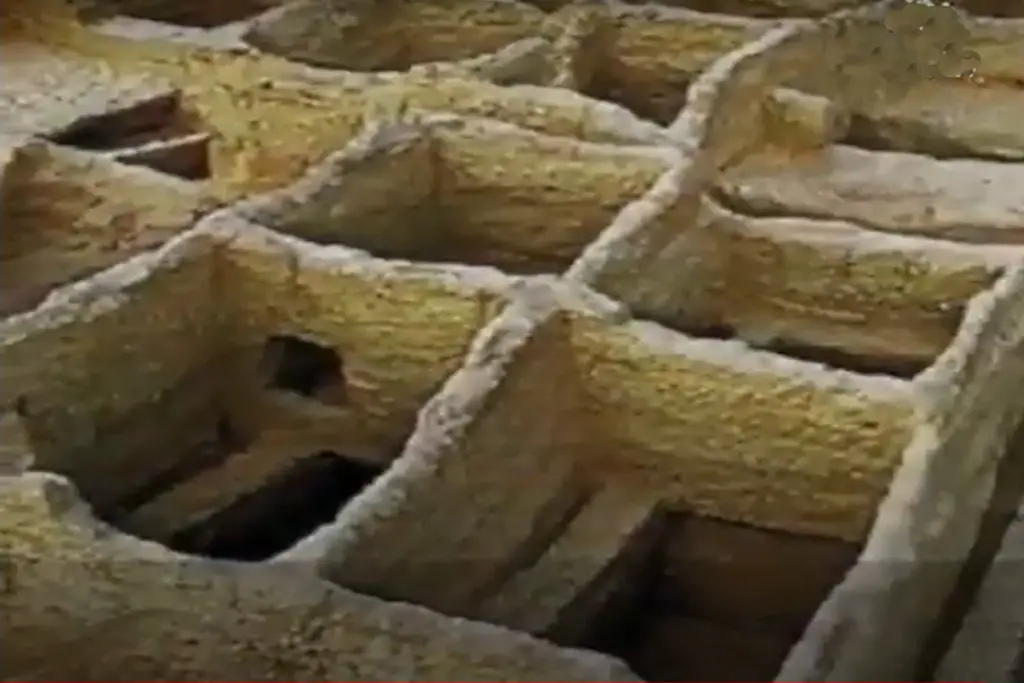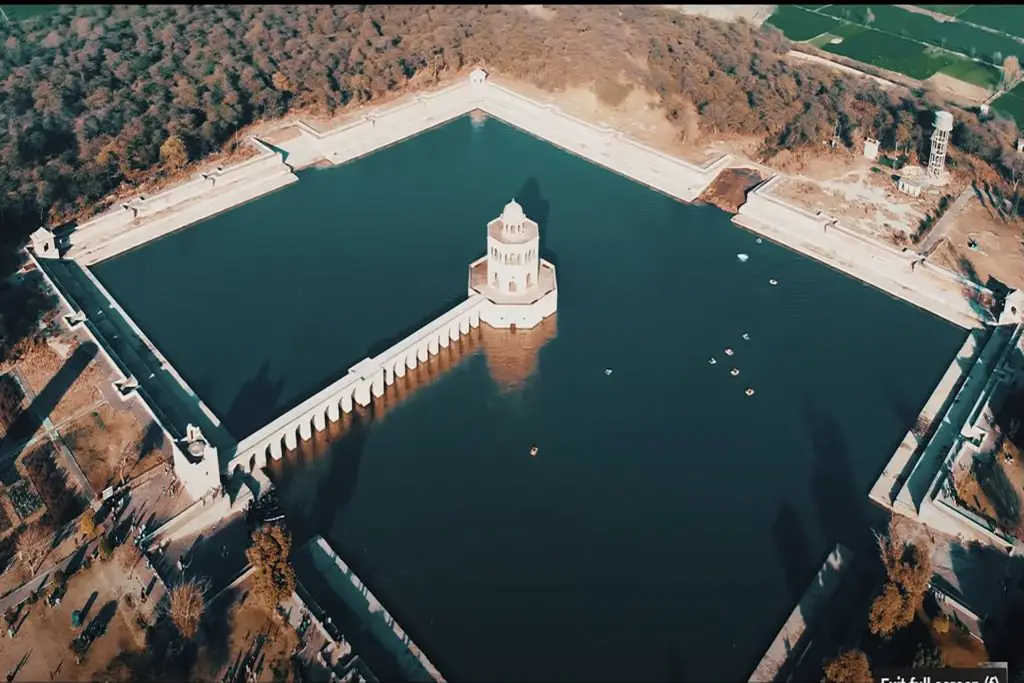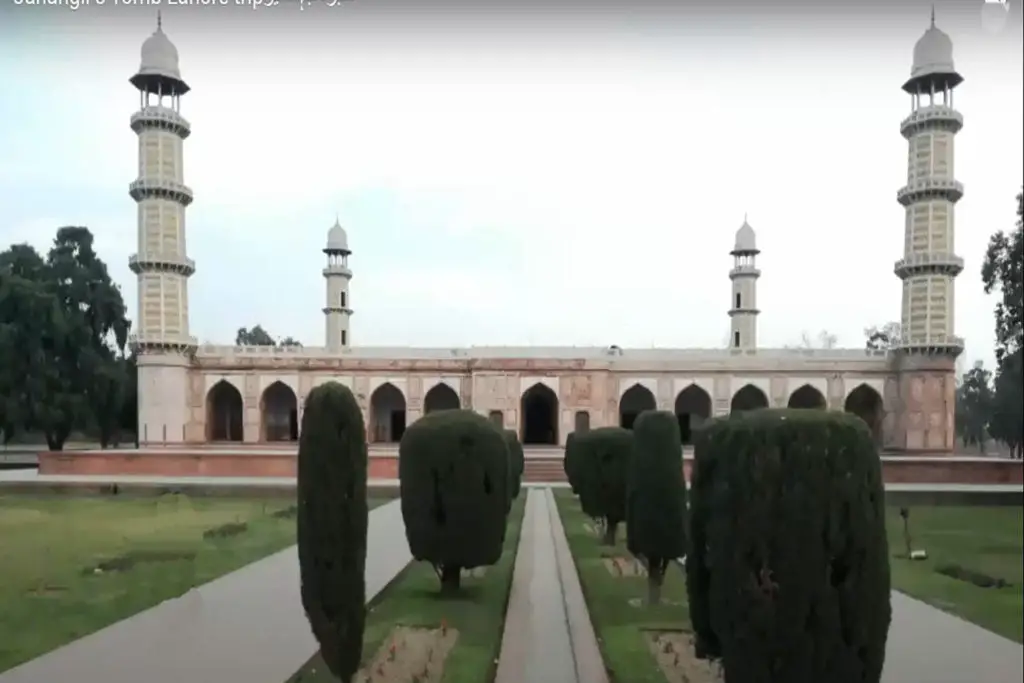Mehrgarh is a Neolithic archaeological site (dated c. 7000 BC – c. 2500/2000 BC) located on the Kacchi Plain in Baluchistan, Pakistan.
Mehrgarh ruins in Pakistan
Ruins of the Mehrgarh Civilization are located near the Bolan Pass, west of the Indus River, and between the present-day Pakistani cities of Quetta, Kalat, and Sibi. The site was discovered in 1974 by an archaeological team led by French archaeologists Jean-François Jarrige and his wife Catherine Jarrige. Mehrgarh was excavated continuously between 1974 and 1986 and again from 1997 to 2000.
Archaeological material was found in six barrows and about 32,000 artifacts were collected at the site. The earliest settlement at Mehrgarh—situated in the northeastern corner of the 495-acre (2.00 km2) site—was a small agricultural village dated to between 7000 and 5500 BCE.
Mehrgarh is one of the first known sites to show evidence of agriculture and pastoralism in South Asia. It was influenced by the Neolithic culture of the Near East, with similarities between “domesticated varieties of wheat, early stages of farming, pottery, other archaeological artifacts, some domesticated plants and herds of animals. According to Asko Parpol, the culture migrated to the Indus Valley and became the Indus Valley Civilization of the Bronze Age.
Mehrgarh was the main center of Mehrgarh civilization. It was here that the first traces of this civilization were discovered, hence the name Mehrgarh Civilization. Apart from Mehrgarh, there were many other centers of this civilization.
Most of these centers are located in the Kachchi Plain of the Indus Valley. Other important centers of this civilization are Tarkaikella, Sherikhan Tarkai, Kachchibeg, Muldigak, Periyanna Khunthai, Rana Ghunrai, Kili Gul Mohammad, Nausera, Amarinal, Nundra, Kulli, Kot Diji, Gajishah, Tharae etc.
Time Period of Mehrgarh Civilization
Archaeologists divide the occupation of the site into eight periods.
Mehrgarh I Period (before 7000 BC–5500 BC)
The Mehrgarh I period (before 7000 BC – 5500 BC) was Neolithic and Ceramic (without the use of pottery). The earliest agriculture in the area was developed by semi-nomadic people who used plants such as wheat and barley and animals such as sheep, goats, and cattle. The settlement was founded with mud brick buildings and most of them had four internal divisions.
Many burials have been found, many with elaborate wares such as baskets, stone and bone tools, beads, bracelets, pendants, and occasionally animal sacrifices, with more wares remaining with male burials.
Ornaments of seashells, limestone, turquoise, lapis lazuli, and sandstone were found, along with simple figurines of women and animals. Shells from distant sea shores and lapis lazuli from as far away as today’s Badakhshan show good contact with these areas.
One ground stone ax was discovered in the burial and several others were recovered from the surface. These ground stone axes first come from a stratified context in South Asia.
Mehrgarh Period II (5500 BCE-4800 BCE) and Mehrgarh Period III (4800 BCE-3500 BCE)
The Mehrgarh II (5500 BC – 4800 BC) and Merhgarh III (4800 BC – 3500 BC) periods were Ceramic Neolithic using pottery and later Chalcolithic. Period II is at site MR4 and Period III is at MR2.[43] Much evidence of manufacturing activity was found and more advanced techniques were used. Glazed faience beads were made and terracotta figurines were more detailed.
The female figurines were decorated with paint and had different hairstyles and ornaments. In Period II, two bent burials were found with a red ocher covering on the body. The number of funerary goods decreased over time, was limited to ornaments, and goods with the burial of women increased. The first button seals were made of terracotta and bone and had geometric designs.
Technologies included stone and copper drills, updraft furnaces, large pit furnaces, and copper smelting crucibles.
There is further evidence of long-distance trade in Period II: important evidence of this is the discovery of several lapis lazuli beads, again from Badakshan. The Mehrgarh II and III periods also coincide with the expansion of settled populations in the borderland on the western fringes of South Asia, including the establishment of settlements such as Rana Ghundai, Sheri Khan Tarakai, Sarai Kala, Jalilpur, and Ghaligai.
Period III has not been explored much, but the Togau phase (ca. 4000-3500 BC) was found to be part of this level and covered about 100 hectares in areas MR.2, MR.4, MR.5 and MR.6., including ruins, burial sites, and landfills, but archaeologist Jean-François Jarrige concluded that “such a widespread was not due to a contemporary occupation, but rather due to a temporal shift and partial overlapping of several villages or clustering of settlements over a span of several centuries”.
Togau phase
At the beginning of Mehrgarh III, Togau pottery appeared at the site. Togau ware was first defined by Beatrice de Cardi in 1948. Togau is a large mound in the Chhappar Valley of Sarawan, 12 kilometers northwest of Kalat, Baluchistan. This type of pottery is abundant in Baluchistan and eastern Afghanistan, at places such as Mundigak, Sheri Khan Tarakai, and Periano Ghundai. According to Possehl, it is current in 84 places. Anjira is a contemporary ancient site near Togau.
Togau ceramics are decorated with geometric patterns and were already produced on the potter’s wheel.
Mehrgarh Periods IV, V and VI (3500 BC–3000 BC)
Period IV was 3500 to 3250 BC.
Period V from 3250 to 3000 BCE and
Period VI was around 3000 BCE.
The site containing periods IV to VII is designated MR1.
Mehrgarh Period VII (2600 BC–2000 BC)
Sometime between 2600 BC and 2000 BC, the city appears to have been largely abandoned in favor of the larger and fortified city of Nausharo five miles away, when the Indus Valley Civilization was in its middle stages of development. Historian Michael Wood suggests that this occurred around 2500 BC.
Archaeologist Massimo Vidale believes that a series of half-pillars found in a structure at Mehrgarh, dated to around 2500 BC by the French mission there, are very similar to half-pillars found in Period IV at Shahr-i Sokhta.
Mehrgarh Period VIII
The latest period is located in the Sibri cemetery, about 8 kilometers from Mehrgarh.
Lifestyle and Technology of Mehrgarh Civilization
The first inhabitants of Mehrgarh lived in mud brick houses, stored grain in granaries, made tools from the local copper ore, and lined their large basket vessels with bitumen. They grew six-row barley, einkorn and einkorn wheat, jujube, and dates, and grazed sheep, goats, and cattle.
The inhabitants of the later period (5500 BC to 2600 BC) put great effort into crafts, including flint breaking, tanning, bead making, and metalworking. Mehrgarh is probably the oldest known center of agriculture in South Asia.
The oldest known example of the lost wax technique comes from a 6,000-year-old copper wheel-shaped amulet found at Mehrgarh. The amulet was made of unalloyed copper, an unusual innovation that was later abandoned.
Is Mehrgarh the oldest Civilization?
Older than Mohenjodaro, Mehrgarh represents the oldest and most neglected civilization in the region. Balochistan’s cultural and historical heritage has been lost in the landscape of social strife that engulfs it.
Meaning of Mehrgarh
Mehrgarh is considered one of the most important Neolithic sites in archaeology. It is now considered to be the forerunner of the Indus Valley Civilization. His discovery shed new light on the development of agricultural technology and the agrarian lifestyle of the ancient Stone Age people of South Asia.
The Most Important Feature of the Mehrgarh Civilization
The most significant feature of Mehrgarh is the fact that one can observe its gradual development from an early village society to a regional center which at its peak covered an area of 200 hectares.
How was Mehrgarh destroyed?
Worst of all, during the dispute between the Rind and Raisani tribes, the site of Mehrgarh was bulldozed by the Rinds. The place was under Raisani control, but it was also claimed by the Rind tribe – so they destroyed it.
What was found in Mehrgarh?
At the ancient site of Mehrgarh, where the earliest evidence was found, barley was the dominant crop and was apparently supplemented by wheat. The barley found there is a well-developed domesticated six-rowed barley.
What type of Ornaments were found at Mehrgarh?
Ornaments of seashells, limestone, turquoise, lapis lazuli, sandstone, and polished copper were found, along with simple figurines of women and animals. Seashells from a distant seashore and lapis lazuli found far away in Badakhshan, Afghanistan show good contact with these areas.
When was cotton grown in Mehrgarh?
Pakistan is among the pioneer areas of cotton cultivation: the earliest known traces of cotton were found at Mehrgarh near the city of Quetta: a copper bead with cotton threads was found in a Neolithic burial site from ~6000 BC.
Advancement of Civilization:
A total of 7 stages have been observed in the Mehrgarh civilization. In the first 3 of these phases, every feature of the Neolithic exists. The revolutionary progress of this time is also evident in this civilization.
1. Tools and other materials:
Various Neolithic tools have been discovered in the Mehrgarh civilization. Tools were mainly made of stone. The oldest tool in agricultural machinery is a sickle made of bitumen. Other materials including tools included scythe, pottery, šilnara, jata, humanist, grass, various types of small stone tools, etc. However, in addition to stones, bone tools of this period were also discovered here.
2. Settlement:
At first, hunting and later animal husbandry was the main livelihood of the local people. At that time, people were nomads. Later, people left the nomadic life settled in certain places, and started oil and agriculture. In the Mehrgarh civilization, people built houses of equal size from bricks or mud. Later, the use of bricks of different sizes increased further. Some houses were built on stone foundations. There was also a system to keep the house warm by lighting a fire.
3. Uses of copper:
Although the Mehrgarh civilization developed based on the use of stone, a copper bead recovered from the first stage of this civilization indicates that the people of this civilization mastered the process of smelting copper. In the third phase, copper seals were discovered here.
In addition, at least 14 copper-smelting earthenware pots containing copper remains were found in this phase. In principle, the third stage of this civilization can be described as the Copper and Stone Ages.
4. Burial of corpses:
There is a specialty in the Mehrgarh civilization regarding the burial of corpses. Use of ocher soil: Before the corpse was buried, the body was covered with ocher soil. Belief in the afterlife: Animals, various tools, ornaments, sapphires, sapphires, etc. were given along with the corpse during burial.
From these things, it can be concluded that the people of this civilization believed in the afterlife. These objects were placed in the tomb in the belief that the soul of the corpse would use the objects in the afterlife.
5. Social inequality:
There is evidence that there was considerable social inequality in the Mehrgarh civilization. The presence of lots of valuables with corpses in graves here and there and their absence in graves proves this social inequality.
6. Foreign relations:
Mehrgarh civilization is known to have been associated with various foreign civilizations in the ancient past. Scholars have speculated that this civilization was associated with Central Asia, Afghanistan, Persia, etc. based on the type of pottery, construction methods, and use of sapphires. Professor. Ranbir Chakraborty thinks that the shell and lapis lazuli came here from outside.
7. Economic Life:
In the early days of the Mehrgarh civilization, hunting and animal husbandry were the main livelihoods of the people. Later, agriculture developed here. Various industries and crafts are also known to have developed here.
Agriculture:
The first agricultural and livestock economy in India was developed in the Mehrgarh civilization. Evidence of wheat and barley tea was found here. People here are building six dams in different parts of the river. Irrigation was provided in the agricultural land.
This led to a substantial increase in worm production. Granaries for storing surplus grain were also built here. Agriculture was produced mainly for the benefit of the inhabitants. In the third stage of this civilization, agriculture made great progress. Archaeologist Gordon Child called the discovery and advancement of agricultural methods in the Neolithic the Neolithic Revolution.
Animal husbandry:
In the Mehrgarh civilization, the importance of animal husbandry for agricultural purposes increased. In addition, meat was treated as food. However, in addition to agriculture and animal husbandry, hunting for food still prevailed.
However, there is evidence that the meat of domesticated animals was eaten by later humans rather than hunted wild animals. At first, they raised goats, and humped sheep, sheep, and other animals. Later, sheep and other animals were kept side by side.
Ceramics:
The Mehrgarh civilization saw considerable progress in pottery. At first, ceramics were made by hand. Later, the technique of making pottery using spinning wheels was imported from West Asia to the Mehrgarh civilization.
As a result, the Mehrgarh civilization began using spinning wheels for pottery production around 4000 BC. Unimaginable progress was made in the pottery industry when pottery was put into the kiln and coated with different colors. In addition to the daily dishes, it can be inferred from this pattern that clay idols of women and cattle were made in this civilization.
Weaving:
There is evidence that weaving took place in the Mehrgarh civilization. Many cotton seeds were found here. It is considered to be the oldest example of cotton cultivation in India. It can be assumed that cotton was made from cotton and used to weave cloth. Patterns of the use of various hand-sewn garments were also discovered here.
Other industries:
Various other industries and technologies were developed in the Mehrgarh civilization. One of them was the ornamental industry. The ornaments were made of stone. Six shells, sapphires, rubies, lapis lazuli, etc. were widely used.
Various daily necessities and household items were discovered in the Mehrgarh civilization. The inhabitants used them in everyday life. There are also examples of reed baskets, lame animal clothing, etc. In addition, furnaces for keeping the house warm, Gallaghers, seals, swastika marks, etc. have been discovered.
Trade:
From a copper seal found in the third phase of the Mehrgarh civilization, it is inferred that the people of this civilization were involved in trade and commerce.
Dr. Ranbir Chakraborty supports this view. Merchants marked their products with copper seals. Traders are domestic and foreign. Scholars believe that this type was associated with trade. One of the trade goods was surplus agricultural products.
Final consequences and the end of civilization
The final development of the Mehrgarh civilization can be seen in the fourth to seventh phases here. The rural Mehrgarh civilization gradually shifted to urban life during this period, which later evolved into the Indus or Harappan civilization of Baluchistan.
Professor. Bratindranath Mukhopadhyay, Dr. Dilip Chakraborty, and Dr. Historians such as Shirin Ratnagar consider the later Indus civilization to be the successor of the earlier Mehrgarh civilization.
Bratindranath Mukhopadhyay thinks that the Mehrgarh urbanization took shape in the later Indus Civilization. However, after a long existence, the Mehrgarh civilization, the oldest in the subcontinent, came to an end around 2500 BC.







